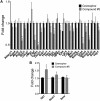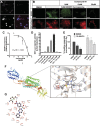Radiation mitigation of the intestinal acute radiation injury in mice by 1-[(4-nitrophenyl)sulfonyl]-4-phenylpiperazine
- PMID: 31464098
- PMCID: PMC6954722
- DOI: 10.1002/sctm.19-0136
Radiation mitigation of the intestinal acute radiation injury in mice by 1-[(4-nitrophenyl)sulfonyl]-4-phenylpiperazine
Abstract
The objective of the study was to identify the mechanism of action for a radiation mitigator of the gastrointestinal (GI) acute radiation syndrome (ARS), identified in an unbiased high-throughput screen. We used mice irradiated with a lethal dose of radiation and treated with daily injections of the radiation mitigator 1-[(4-nitrophenyl)sulfonyl]-4-phenylpiperazine to study its effects on key pathways involved in intestinal stem cell (ISC) maintenance. RNASeq, quantitative reverse transcriptase-polymerase chain reaction, and immunohistochemistry were performed to identify pathways engaged after drug treatment. Target validation was performed with competition assays, reporter cells, and in silico docking. 1-[(4-Nitrophenyl)sulfonyl]-4-phenylpiperazine activates Hedgehog signaling by binding to the transmembrane domain of Smoothened, thereby expanding the ISC pool, increasing the number of regenerating crypts and preventing the GI-ARS. We conclude that Smoothened is a target for radiation mitigation in the small intestine that could be explored for use in radiation accidents as well as to mitigate normal tissue toxicity during and after radiotherapy of the abdomen.
Keywords: acute radiation syndrome; developmental signaling; intestinal stem cells; radiation.
© 2019 The Authors. Stem Cells Translational Medicine published by Wiley Periodicals, Inc. on behalf of AlphaMed Press.
Conflict of interest statement
The authors declare no potential conflict of interest.
Figures







Similar articles
-
1-[(4-Nitrophenyl)sulfonyl]-4-phenylpiperazine treatment after brain irradiation preserves cognitive function in mice.Neuro Oncol. 2020 Oct 14;22(10):1484-1494. doi: 10.1093/neuonc/noaa095. Neuro Oncol. 2020. PMID: 32291451 Free PMC article.
-
1-(4-nitrobenzenesulfonyl)-4-penylpiperazine increases the number of Peyer's patch-associated regenerating crypts in the small intestines after radiation injury.Radiother Oncol. 2019 Mar;132:8-15. doi: 10.1016/j.radonc.2018.11.011. Epub 2018 Dec 20. Radiother Oncol. 2019. PMID: 30825974 Free PMC article.
-
Therapeutic mechanism of Liangxue-Guyuan-Yishen decoction on intestinal stem cells and tight junction proteins in gastrointestinal acute radiation syndrome rats.J Radiat Res. 2023 Nov 21;64(6):880-892. doi: 10.1093/jrr/rrad065. J Radiat Res. 2023. PMID: 37697698 Free PMC article.
-
BCN057 induces intestinal stem cell repair and mitigates radiation-induced intestinal injury.Stem Cell Res Ther. 2018 Feb 2;9(1):26. doi: 10.1186/s13287-017-0763-3. Stem Cell Res Ther. 2018. PMID: 29394953 Free PMC article.
-
Pharmacological countermeasures for the acute radiation syndrome.Curr Mol Pharmacol. 2009 Jan;2(1):122-33. doi: 10.2174/1874467210902010122. Curr Mol Pharmacol. 2009. PMID: 20021452 Review.
Cited by
-
Design, Synthesis, and Biological Evaluation of a Novel Aminothiol Compound as Potential Radioprotector.Oxid Med Cell Longev. 2021 Aug 21;2021:4714649. doi: 10.1155/2021/4714649. eCollection 2021. Oxid Med Cell Longev. 2021. PMID: 34471464 Free PMC article.
-
The Radiation-Induced Regenerative Response of Adult Tissue-Specific Stem Cells: Models and Signaling Pathways.Cancers (Basel). 2021 Feb 18;13(4):855. doi: 10.3390/cancers13040855. Cancers (Basel). 2021. PMID: 33670536 Free PMC article. Review.
-
Classes of Drugs that Mitigate Radiation Syndromes.Front Pharmacol. 2021 May 18;12:666776. doi: 10.3389/fphar.2021.666776. eCollection 2021. Front Pharmacol. 2021. PMID: 34084139 Free PMC article.
-
Social Hierarchy Dictates Intestinal Radiation Injury in a Gut Microbiota-Dependent Manner.Int J Mol Sci. 2022 Oct 29;23(21):13189. doi: 10.3390/ijms232113189. Int J Mol Sci. 2022. PMID: 36361976 Free PMC article.
-
1-[(4-Nitrophenyl)sulfonyl]-4-phenylpiperazine treatment after brain irradiation preserves cognitive function in mice.Neuro Oncol. 2020 Oct 14;22(10):1484-1494. doi: 10.1093/neuonc/noaa095. Neuro Oncol. 2020. PMID: 32291451 Free PMC article.
References
-
- Warren S, Bowers JZ. The acute radiation syndrome in man. Ann Intern Med. 1950;32:207‐216. - PubMed
-
- Weisdorf D, Chao N, Waselenko JK, et al. Acute radiation injury: contingency planning for triage, supportive care, and transplantation. Biol Blood Marrow Transplant. 2006;12:672‐682. - PubMed
-
- Withers HR, Elkind MM. Radiosensitivity and fractionation response of crypt cells of mouse jejunum. Radiat Res. 1969;38:598‐613. - PubMed
-
- Withers HR, Elkind MM. Microcolony survival assay for cells of mouse intestinal mucosa exposed to radiation. Int J Radiat Biol Relat Stud Phys Chem Med. 1970;17:261‐267. - PubMed
-
- Sato T, Vries RG, Snippert HJ, et al. Single Lgr5 stem cells build crypt‐villus structures in vitro without a mesenchymal niche. Nature. 2009;459:262‐265. - PubMed

